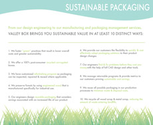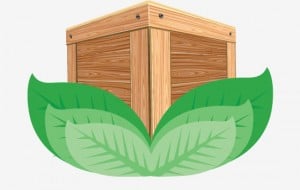
You’ve probably heard of green building, green design, and green power, but how about green crating? If you haven’t heard about it yet, here’s what it's all about.
Green crating follows the same general principles as green building, design, and power. Sustainable companies manufacture and deliver products and services to create experiences while remaining sensitive to environmental issues and achieving greater efficiency and effectiveness in terms of energy and materials.
To jump on the green bandwagon, all you have to do is make green "choices" by following a few golden rules -- err green rules. Whether you’re sending large reusable shipping crates overseas or shipping small wooden crates locally.
To ensure that your crating is always as green as it can be:
Choose efficient designs
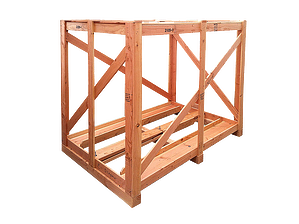 Choose crating designs that typically use less material. Less material reduces the number of resources needed for manufacturing and it reduces trash output—making it more eco-friendly. If your product is semi-durable consider an open crate which is ideal when shipping items bare or when full boxing is cost-prohibitive. This style crate can provide exterior protection along with vertical protection when stacking is a concern. The crate is also lighter than an enclosed box potentially lowering your overall packaging and shipping cost.
Choose crating designs that typically use less material. Less material reduces the number of resources needed for manufacturing and it reduces trash output—making it more eco-friendly. If your product is semi-durable consider an open crate which is ideal when shipping items bare or when full boxing is cost-prohibitive. This style crate can provide exterior protection along with vertical protection when stacking is a concern. The crate is also lighter than an enclosed box potentially lowering your overall packaging and shipping cost.
Choose biodegradable
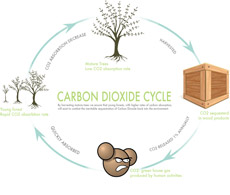 Select biodegradable materials which break down quickly and efficiently with very little impact on the environment. Did you know that Wood is the ultimate “green” product? Wood is renewable, sustainable, recyclable, grown locally, versatile, biodegradable, and has a smaller energy, water, and carbon life cycle footprint than other products.
Select biodegradable materials which break down quickly and efficiently with very little impact on the environment. Did you know that Wood is the ultimate “green” product? Wood is renewable, sustainable, recyclable, grown locally, versatile, biodegradable, and has a smaller energy, water, and carbon life cycle footprint than other products.
Wood crates create a net reduction in global emissions because the
stored carbon is offset by new forest growth & carbon capture.
Choose sustainable practices
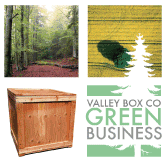 Pick companies that have sustainable manufacturing practices. EcoSeed says, green packaging is produced in an environmentally conscious way when the company uses energy efficiently and the facility has low pollution emissions. For example, some factories harness green energy sources, such as wind power, to drive their plant's production.
Pick companies that have sustainable manufacturing practices. EcoSeed says, green packaging is produced in an environmentally conscious way when the company uses energy efficiently and the facility has low pollution emissions. For example, some factories harness green energy sources, such as wind power, to drive their plant's production.
Choose non-toxic
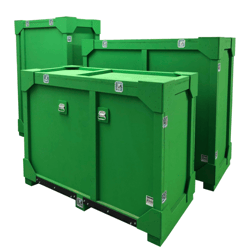 Choose crating that does not contain toxic chemicals. Toxic chemicals are poisonous to plants, animals, and humans. If inhaled, ingested, or absorbed into the skin, toxic chemicals can cause everything from a single reaction (such as coughing or wheezing) to death.
Choose crating that does not contain toxic chemicals. Toxic chemicals are poisonous to plants, animals, and humans. If inhaled, ingested, or absorbed into the skin, toxic chemicals can cause everything from a single reaction (such as coughing or wheezing) to death.
In the environment, toxic chemicals can cause the greenhouse effect and climate change, ozone depletion, the build-up of toxic algae in rivers, and acid rain, which poisons fish and hinders the ability of soil to support plant life.
Valley Box uses kiln-dried heat-treated lumber without chemicals. Many pallets are treated with methyl bromide — a toxic pesticide that has been linked to human health problems and ozone layer depletion.
Choose recyclable
 Valley Box incorporates sustainable business practices into our operations by recycling all wood scrap with commercial recycling services. Wood scrap becomes wood mulch, which protects bare soils and offers:
Valley Box incorporates sustainable business practices into our operations by recycling all wood scrap with commercial recycling services. Wood scrap becomes wood mulch, which protects bare soils and offers:
- Erosion Control
- Sediment control
- Tracking Control
- Wind Erosion Control
- Non-stormwater Management Control
- Waste Management
- Materials Pollution Control
Wood scrap also can become biofuel. Bioenergy technologies produce many energy-related products including: - Electricity
- Liquid, solid, and gaseous fuels
- Heat
- Chemicals
Fortunately, Valley Box can help keep you on track in your quest for greener crating. Valley Box fosters “green” practices that result in lower overall costs & greater sustainability. To learn more about Valley Box’s sustainable practices visit our Green Business Section.
- We reuse all possible crating in our production processes to minimize waste & disposal costs
- We recycle all wood scrap & metal scrap, which reduces the amount of waste entering landfills.


